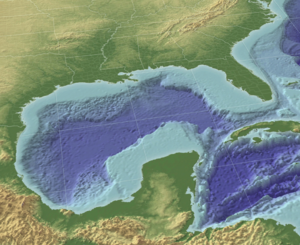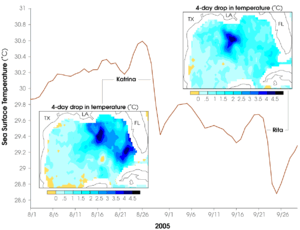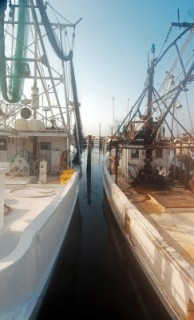Difference between revisions of "Gulf of Mexico" - New World Encyclopedia
Vicki Phelps (talk | contribs) |
Vicki Phelps (talk | contribs) |
||
| Line 2: | Line 2: | ||
[[Image:GulfofMexico3D.png|thumb|right|300px|Gulf of Mexico in 3D perspective.]] | [[Image:GulfofMexico3D.png|thumb|right|300px|Gulf of Mexico in 3D perspective.]] | ||
| − | The '''Gulf of Mexico''' is the ninth largest | + | The '''Gulf of Mexico''' is the ninth largest body of water in the world. It is an [[ocean]] basin largely surrounded by the [[North America]]n continent and the island of [[Cuba]]. It is bounded on the northeast, north and northwest by the Gulf Coast of the United States, on the southwest and south by [[Mexico]], and on the southeast by [[Cuba]]. The shape of its basin is roughly circular and approximately 810 nautical miles (1,500 km) wide and filled with of [[sedimentary]] rocks and debris. It connects with the [[Atlantic Ocean]] through the Florida Straits between the U.S. and Cuba, and with the [[Caribbean Sea]] via the Yucatan Channel between Mexico and Cuba. Tidal ranges are extremely small due to the narrow connection with the ocean. |
| − | The gulf basin is approximately 615,000 | + | |
| − | It was probably formed approximately 300 million years ago as a result of the | + | The gulf basin is approximately 615,000 mi² (1.6 million km²). Almost half of the basin is shallow intertidal waters. At its deepest it is 14,383 feet (4,384 m) at the Sigsbee Deep, an irregular trough more than 300 nautical miles (550 km) long. It was probably formed approximately 300 million years ago as a result of the sea floor sinking.<ref name="epa">{{cite web |
|url=http://www.epa.gov/gmpo/about/facts.html | |url=http://www.epa.gov/gmpo/about/facts.html | ||
|title=General Facts about the Gulf of Mexico | |title=General Facts about the Gulf of Mexico | ||
|publisher= | |publisher= | ||
|accessdate=2006-12-27 | |accessdate=2006-12-27 | ||
| − | }}</ref> There is evidence that the | + | }}</ref> There is evidence that the Chicxulub Crater was formed when a large [[meteorite]] hit Earth 65 million years ago, which may have affected the [[extinction]] of the [[dinosaur]]s.<ref>{{cite web | url=http://web.ukonline.co.uk/a.buckley/dino.htm | title=Dinosaur Extinction Page | first=A. | last=Buckley | year=1997}}</ref> |
| − | == | + | ==Geography== |
==Principal features== | ==Principal features== | ||
[[Image:Wide natural beach near Sabine Pass.jpg|thumb|left|300px|Gulf beach near Sabine Pass.]] | [[Image:Wide natural beach near Sabine Pass.jpg|thumb|left|300px|Gulf beach near Sabine Pass.]] | ||
| Line 19: | Line 19: | ||
|publisher=epa.gov | |publisher=epa.gov | ||
|accessdate=2007-01-21 | |accessdate=2007-01-21 | ||
| − | }}</ref> The Gulf's southwestern and southern shores lie along the [[Mexican]] states of | + | }}</ref> The Gulf's southwestern and southern shores lie along the [[Mexico|Mexican]] states of Tamaulipas, Veracruz, Tabasco, Campeche, Yucatán, and the northernmost tip of Quintana Roo. On the southeast it is bordered by [[Cuba]]. It supports major American, Mexican and Cuban fishing industries. The outer margins of the wide continental shelves of Yucatán and Florida receive cooler, nutrient-enriched waters from the deep by a process known as upwelling, which stimulates plankton growth in the euphotic zone. This attracts fish, shrimp, and squid. <ref>{{cite web | url=http://www.tsha.utexas.edu/handbook/online/articles/GG/rrg7.html | title=GULF OF MEXICO | work=Handbook of Texas Online | publisher=Texas State Historical Association}}</ref>. River drainage and atmospheric fallout from industrial coastal cities also provide nutrients to the coastal zone. |
| − | The [[Gulf Stream]], a warm Atlantic Ocean current and one of the strongest [[ocean current]]s known, originates in the gulf, as a continuation of the | + | The [[Gulf Stream]], a warm Atlantic Ocean current and one of the strongest [[ocean current]]s known, originates in the gulf, as a continuation of the Caribbean Current-Yucatán Current-Loop Current system. Other circulation features include the anticyclonic gyres which are shed by the Loop Current and travel westward where they eventually dissipate, and a permanent cyclonic gyre in the Bay of Campeche. The Bay of Campeche in Mexico constitutes a major arm of the Gulf of Mexico. Additionally, the gulf's shoreline is fringed by numerous bays and smaller inlets. A number of rivers empty into the gulf, most notably the [[Mississippi River]] in the northern gulf, and the Grijalva and Usumacinta Rivers in the southern gulf. The land that forms the gulf's coast, including many long, narrow barrier islands, is almost uniformly low-lying and is characterized by marshes and swamps as well as stretches of sandy beach. |
| − | The [[continental shelf]] is quite wide at most points along the coast, most notably at the Florida and [[Yucatán Peninsula]]s. | + | The [[continental shelf]] is quite wide at most points along the coast, most notably at the Florida and [[Yucatán Peninsula]]s. The shelf is exploited for its [[petroleum|oil]] by means of offshore drilling rigs, most of which are situated in the western gulf and in the Bay of Campeche. Another important commercial activity is [[fishing]]; major catches include red snapper, amberjack, tilefish, swordfish, and various grouper, as well as shrimp and crabs. [[Oyster]]s are also harvested on a large scale from many of the bays and sounds. Other important industries along the coast include shipping, petrochemical processing and storage, military use, paper manufacture, and [[tourism]]. |
| − | [[Image:GulfMexTemps 2005Hurricanes.gif|thumb|300px|Graph showing the overall water temperature of the Gulf between Hurricanes | + | [[Image:GulfMexTemps 2005Hurricanes.gif|thumb|300px|Graph showing the overall water temperature of the Gulf between Hurricanes Katrina and Rita. Although Katrina cooled waters in its path by up to 4°C, they had rebounded by the time of Rita's appearance.]] |
| − | The gulf's warm water temperature can feed powerful Atlantic [[hurricane]]s causing extensive human death and other destruction as happened with | + | The gulf's warm water temperature can feed powerful Atlantic [[hurricane]]s causing extensive human death and other destruction as happened with Hurricane Katrina in 2005. In the Atlantic, a hurricane will draw up cool water from the depths and making it less likely that further hurricanes will follow in its wake (warm water being one of the preconditions necessary for their formation). However, the Gulf is shallower and its entire water column is warm. When a hurricane passes over, although the water temperature may drop it soon rebounds and becomes capable of supporting another tropical storm.<ref>{{cite web | url=http://earthobservatory.nasa.gov/Newsroom/NewImages/images.php3?img_id=17038 | title=Warm Waters Provide Fuel for Potential Storms | publisher=[[NASA Earth Observatory]] | accessdate=2006-05-05}}</ref> |
| − | The Gulf is considered | + | The Gulf is considered aseismic: however, mild tremors have been recorded throughout history (usually 5.0 or less on the Richter scale). A 6.0 tremor was recorded on September 10, 2006, 250 miles off the coast of [[Florida]] which caused no damage, but could be felt throughout the Southeastern United States. No damage or injuries were reported.<ref>{{cite web |
|url=http://www.wftv.com/news/9817047/detail.html | |url=http://www.wftv.com/news/9817047/detail.html | ||
|title=Central Florida Feels Quake | |title=Central Florida Feels Quake | ||
| Line 51: | Line 51: | ||
}}</ref> that kill fish and marine mammals and cause respiratory problems in humans and some domestic animals when the blooms reach close to shore. This has especially been plaguing the southwest Florida coast, from the [[Florida Keys]] to north of [[Pasco County, Florida]]. | }}</ref> that kill fish and marine mammals and cause respiratory problems in humans and some domestic animals when the blooms reach close to shore. This has especially been plaguing the southwest Florida coast, from the [[Florida Keys]] to north of [[Pasco County, Florida]]. | ||
| + | ==History== | ||
| + | Prior to European settlement, many [[Native American]] tribes inhabited the floodplain areas of the Mississipi River and used the river as a highway, to sustain their villages, and as a geological marker. On May 8, 1541, Hernando de Soto became the first recorded [[Europe]]an to reach the Mississippi River, which he called "'''Rio de Espiritu Santo'''" (''River of the Holy Spirit''). This name is currently the name of the river in the Spanish speaking world. In 1539, De Soto launched the largest of the early Spanish colonial expeditions. A vast undertaking, De Soto's expedition ranged throughout the [[southeastern United States]] searching for gold and a passage to China. De Soto died in 1542 on the banks of the [[Mississippi River]] at present-day [[Lake Village, Arkansas]]. | ||
| + | after DeSoto arrived in America. Indians became itinerants to avoid diseases in population centers; their great nations, their cities and their giant farms, all described by DeSoto's people, no longer existed. Indian cities were abandoned: the people fled for refuge. DeSoto's accounts were eventually dismissed by French and English pioneers, given the tremendous short-term changes in the North America he visited. | ||
==References== | ==References== | ||
| Line 64: | Line 67: | ||
*[http://www.ncat.org/nutrients/hypoxia/hypoxia.html Gulf of Mexico hypoxia] | *[http://www.ncat.org/nutrients/hypoxia/hypoxia.html Gulf of Mexico hypoxia] | ||
*[http://gulfsci.usgs.gov/ Gulf of Mexico Integrated Science] | *[http://gulfsci.usgs.gov/ Gulf of Mexico Integrated Science] | ||
| + | *[http://floridahistory.com/inset33.html] Hernando de Soto site | ||
==Gallery== | ==Gallery== | ||
Revision as of 00:54, 17 December 2007
The Gulf of Mexico is the ninth largest body of water in the world. It is an ocean basin largely surrounded by the North American continent and the island of Cuba. It is bounded on the northeast, north and northwest by the Gulf Coast of the United States, on the southwest and south by Mexico, and on the southeast by Cuba. The shape of its basin is roughly circular and approximately 810 nautical miles (1,500 km) wide and filled with of sedimentary rocks and debris. It connects with the Atlantic Ocean through the Florida Straits between the U.S. and Cuba, and with the Caribbean Sea via the Yucatan Channel between Mexico and Cuba. Tidal ranges are extremely small due to the narrow connection with the ocean.
The gulf basin is approximately 615,000 mi² (1.6 million km²). Almost half of the basin is shallow intertidal waters. At its deepest it is 14,383 feet (4,384 m) at the Sigsbee Deep, an irregular trough more than 300 nautical miles (550 km) long. It was probably formed approximately 300 million years ago as a result of the sea floor sinking.[1] There is evidence that the Chicxulub Crater was formed when a large meteorite hit Earth 65 million years ago, which may have affected the extinction of the dinosaurs.[2]
Geography
Principal features
The Gulf of Mexico's eastern, north, and northwestern shores lie along the US states of Florida, Alabama, Mississippi, Louisiana, and Texas. This coastline spans 1,630 miles, receiving water from thirty-three major rivers that drain 31 states.[3] The Gulf's southwestern and southern shores lie along the Mexican states of Tamaulipas, Veracruz, Tabasco, Campeche, Yucatán, and the northernmost tip of Quintana Roo. On the southeast it is bordered by Cuba. It supports major American, Mexican and Cuban fishing industries. The outer margins of the wide continental shelves of Yucatán and Florida receive cooler, nutrient-enriched waters from the deep by a process known as upwelling, which stimulates plankton growth in the euphotic zone. This attracts fish, shrimp, and squid. [4]. River drainage and atmospheric fallout from industrial coastal cities also provide nutrients to the coastal zone.
The Gulf Stream, a warm Atlantic Ocean current and one of the strongest ocean currents known, originates in the gulf, as a continuation of the Caribbean Current-Yucatán Current-Loop Current system. Other circulation features include the anticyclonic gyres which are shed by the Loop Current and travel westward where they eventually dissipate, and a permanent cyclonic gyre in the Bay of Campeche. The Bay of Campeche in Mexico constitutes a major arm of the Gulf of Mexico. Additionally, the gulf's shoreline is fringed by numerous bays and smaller inlets. A number of rivers empty into the gulf, most notably the Mississippi River in the northern gulf, and the Grijalva and Usumacinta Rivers in the southern gulf. The land that forms the gulf's coast, including many long, narrow barrier islands, is almost uniformly low-lying and is characterized by marshes and swamps as well as stretches of sandy beach.
The continental shelf is quite wide at most points along the coast, most notably at the Florida and Yucatán Peninsulas. The shelf is exploited for its oil by means of offshore drilling rigs, most of which are situated in the western gulf and in the Bay of Campeche. Another important commercial activity is fishing; major catches include red snapper, amberjack, tilefish, swordfish, and various grouper, as well as shrimp and crabs. Oysters are also harvested on a large scale from many of the bays and sounds. Other important industries along the coast include shipping, petrochemical processing and storage, military use, paper manufacture, and tourism.
The gulf's warm water temperature can feed powerful Atlantic hurricanes causing extensive human death and other destruction as happened with Hurricane Katrina in 2005. In the Atlantic, a hurricane will draw up cool water from the depths and making it less likely that further hurricanes will follow in its wake (warm water being one of the preconditions necessary for their formation). However, the Gulf is shallower and its entire water column is warm. When a hurricane passes over, although the water temperature may drop it soon rebounds and becomes capable of supporting another tropical storm.[5]
The Gulf is considered aseismic: however, mild tremors have been recorded throughout history (usually 5.0 or less on the Richter scale). A 6.0 tremor was recorded on September 10, 2006, 250 miles off the coast of Florida which caused no damage, but could be felt throughout the Southeastern United States. No damage or injuries were reported.[6] Earthquakes such as this may be caused by interactions between sediment loading on the sea floor and adjustment by the crust.[7]
Pollution
Because of the ever increasing amount of nitrogen and phosphates dissolved in the waters of the Gulf of Mexico, pollution has more than doubled since 1950. Current estimates suggest that three times as much nitrogen is being carried into the Gulf today compared with levels 30 years ago or at any time in history in the water. Every summer there is now an area south of the Louisiana coastline, larger than the U.S. state of Massachusetts at over 7,000 mi² (18,000 km²) that is hypoxic. These waters do not carry enough oxygen to sustain marine life. This annually enlarging dead zone is a major threat to the fishing industry and to public health.
Also, there are frequent "red tide" algae blooms[8] that kill fish and marine mammals and cause respiratory problems in humans and some domestic animals when the blooms reach close to shore. This has especially been plaguing the southwest Florida coast, from the Florida Keys to north of Pasco County, Florida.
History
Prior to European settlement, many Native American tribes inhabited the floodplain areas of the Mississipi River and used the river as a highway, to sustain their villages, and as a geological marker. On May 8, 1541, Hernando de Soto became the first recorded European to reach the Mississippi River, which he called "Rio de Espiritu Santo" (River of the Holy Spirit). This name is currently the name of the river in the Spanish speaking world. In 1539, De Soto launched the largest of the early Spanish colonial expeditions. A vast undertaking, De Soto's expedition ranged throughout the southeastern United States searching for gold and a passage to China. De Soto died in 1542 on the banks of the Mississippi River at present-day Lake Village, Arkansas.
after DeSoto arrived in America. Indians became itinerants to avoid diseases in population centers; their great nations, their cities and their giant farms, all described by DeSoto's people, no longer existed. Indian cities were abandoned: the people fled for refuge. DeSoto's accounts were eventually dismissed by French and English pioneers, given the tremendous short-term changes in the North America he visited.
ReferencesISBN links support NWE through referral fees
- ↑ General Facts about the Gulf of Mexico. Retrieved 2006-12-27.
- ↑ Buckley, A. (1997). Dinosaur Extinction Page.
- ↑ National Water Program Guidance: FY 2005. epa.gov. Retrieved 2007-01-21.
- ↑ GULF OF MEXICO. Handbook of Texas Online. Texas State Historical Association.
- ↑ Warm Waters Provide Fuel for Potential Storms. NASA Earth Observatory. Retrieved 2006-05-05.
- ↑ Central Florida Feels Quake. Retrieved 2006-12-27.
- ↑ Earthquakes in the Gulf of Mexico. Retrieved 2006-12-27.
- ↑ The Gulf of Mexico Dead Zone and Red Tides. Retrieved 2006-12-27.
External links
- 6.0 Earthquake reported on 9-10-2006
- GSA article on Gulf seismic activity from 1982
- EPA factsheet on hypoxia
- Gulf of Mexico hypoxia
- Gulf of Mexico Integrated Science
- [1] Hernando de Soto site
Gallery
Credits
New World Encyclopedia writers and editors rewrote and completed the Wikipedia article in accordance with New World Encyclopedia standards. This article abides by terms of the Creative Commons CC-by-sa 3.0 License (CC-by-sa), which may be used and disseminated with proper attribution. Credit is due under the terms of this license that can reference both the New World Encyclopedia contributors and the selfless volunteer contributors of the Wikimedia Foundation. To cite this article click here for a list of acceptable citing formats.The history of earlier contributions by wikipedians is accessible to researchers here:
The history of this article since it was imported to New World Encyclopedia:
Note: Some restrictions may apply to use of individual images which are separately licensed.






